| Upcoming clinics 2014
March 22nd-23rd.
April 25th-27th
Italy
Centro Equitazione Deiana
( Fara Gera d'Adda, 30 minutes far from Milan
Contact simonasongia@hotmail.it
April 25th-26th-27th, 2014 - Centro Equitazione Deiana, Fara Gera d'Adda (BG)
May 10th-11th
Windy Creek Ranch,
10500 N. 49th St., Longmont, CO 80503.
contact Sarah Barnes,sarahvbarnes@yahoo.com
303 817 2783.
May17th-18th
Science of Motion
Clinic with Jean Luc Cornille
"Soundness Equals Performance"
Auditors: $15 for pre-registered DVCTA members*, $25 non-members or non-registered members.
Dates: Saturday & Sunday, March 8th & 9th 2014
Place: Blue Rock Farm, 1104 Allerton Rd., West Chester, PA 19382
May 24th-27th
Jean Luc Cornille Clinic
Contact:
Andrea Datz
2073 I Road
Fruita, CO
Phone: 970-740-9880
e-mail:ardatz@acsol.net
June 7th-8th
Hillcrest Farm
8431 Heron Pointe Way
Spotsylvania, VA 22551
Contact
Gaby Farnsworth
540-226-5586
June 13th-15th
Jean Luc clinic in Finland contact gunilla.wahlberg@kolumbus.fi Gunilla Wahlberg
July 5th -6th
|
|
Greetings!
Imitated but never Equated
Riding New Knowledge
Imitated but never equated, the science of motion teaches how to ride in the light of new knowledge. This is the fundamental difference from other approaches which refer to science, mostly as a marketing strategy, but promote an equitation that has not evolved from traditional views. With the venue of the "plasticity of muscle function," the inaccuracy of the theories promoting shifts of the rider weight, stretching and great vertebral mobility has been demonstrated. Instead, a dialogue based on subtle nuances in muscle tone and consequently precise control of moderated movements is in line with the new findings. As researches continued to progress, the thought that the horse perceives in fact the energy created by our nuances in muscle tone deserved to be explored. We did, and since we have observed that any theory can produce result as long as the performance is below the horse's talent, we explored the technique for the education of higher level performances, highly difficult horse and challenging cases of rehabilitation. An extraordinary world is now offered to one who wants to know. Lightness, straightness, partnership are now possible at a level that was not accessible to our predecessors. The condition of course is updating classical views to new knowledge. Commenting her one month intensive training under the Science of Motion approach, Carol Shwetz DVM COAC IVAS ECS wrote, "Understanding the functional biomechanics of the horse adds a depth and breadth to this level of horsemanship unknown before in history. As such this experience of horsemanship is delightful beyond words. Studying the scientific insights of functional biomechanics is like studying the eighth wonder of the world. Translating the studies into the riding experience is like knowing the eighth natural wonder of the world." Jean Luc
We have been very busy here with many new activities. The IHTC is a very active part of our daily routine here. The course has grown so much with the addition of our private group on social media. Jean Luc discusses with our students almost daily as well as working with their videos analyzes problems and progress. We have various payment structures which enables you to be able to join the revolution of new teachers in SOM work.
The training program on our farm and new clinics have been extremely active. We will be in Itlay in April and would love to meet some of our overseas members .See the list on left side of newsletter for details. Spring is just a few days away and hope all are enjoying the greening and colors of nature and warmth once again! Sincerely,
Editor Helyn Cornille
Science Of Motion |
|
Oversimplifications
Jean Luc Cornille
"In equitation as in politics, we should beware of oversimplifications; this nearly always complicates matters in the end." (General Decarpentry, 1949)
Decarpentry reflected on the discrepancy between the simplicity of riding principles and the complexity of putting them into practice. In theory, the horse engages the hind legs under his body propelling himself upward and forward. In reality, the forelegs produce the greatest percentage of upward vertical forces, 57% of the vertical impulse is produced by the forelegs while only 43% is produced by the hind legs. This apparent contradiction exposes the over simplicity of fundamental riding principles. Between the engagement of the hind legs and the mastery of balance, a complex mechanism is involved including converting a percentage of the thrust generated by the hind legs into vertical forces. This is done through sophisticated coordination of the back muscles. This coordination can be clearly explained but is not simple. Furthering knowledge through skill and experience used to be the task of great Masters. Decarpentry closely followed the evolution of scientific discoveries. Already in 1949, the classic author sensed that the work of the hind legs was not simply engaging forward under the body and propelling the horse's into balance. Even if his words were not accurate, Decarpentry already sensed the concept of energy stored in long tendons and aponeurosis and used during the propulsion phase. "The degree of elevation of the body during the moment of suspension will depend likewise on the vigor of the effort of the hind legs, and consequently on the amount of previous compressions of their joints." Classical training is not about repeating the words of classic authors. Instead, the role of a real teacher and trainer is furthering our ancestors' ideas through the light of new knowledge. Most of the time, this is not the case and therefore, the rider is the one who has to look and think beyond tradition. A formula such as over-tracking is the type of oversimplification that concentrates the riders' attention on foot prints and lower legs movements, missing proper correlation between limbs movement and thoracolumbar spine mechanism. Over-tracking is theoretically an engagement of the hind legs placing the foot print of the hind leg ahead of the print of the foreleg. In many instances, over-tracking is in fact a kinematics abnormality placing the push off of the foreleg too far back. The horse does not over-track because of greater engagement of the hind leg but instead because over loading of the forelegs and consequent backward shift of the forelegs' stance. Like for every kinematics study, we start with a "control" document used for comparison and reference. The "control" is the work of Eadweard Muybridge, "Animals in motion, 1899." Muybridge pioneered the technique of photographic series. His work pictures average horses in motion. On this first series, the horse is at the trot. The picture series needs to be read from right to left. The two frames that interest us are the first and second frame of the upper line. The left hind leg is close from impact and then alights while the left foreleg moves out of the way into the swing phase. 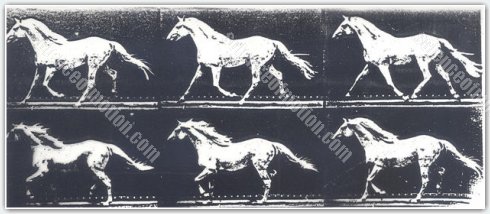
CLICK HERE TO READ ON
|
|
The price of compensations
Chazot Thought's
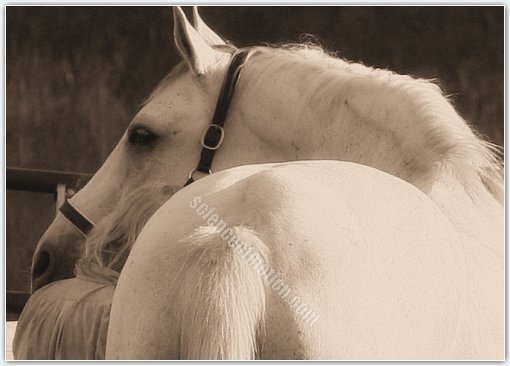
He placed his hand on my front head and I immediately felt the vibration of physical pain. The day started as usual. He entered the barn for our breakfast, opened the Frigidaire filling up his pockets with carrots and started the distribution. Everyone gets a carrot and I get a few more. He starts with me and ends with me leaning on my window. We have then our morning chat. He gives me a kiss on my left eye counting how many stools I made during the night, checking how much water I drank. Meanwhile I am searching with my nose in his hands and his pockets. It is like magic; there are no more carrots and then there is one more.
He rarely talks or even lets any physical pain slowing him down but this one was debilitating. His movements were very slow and controlled as he was preparing our breakfast. I was worried about him and did not eat. I knew that he went through surgery two weeks earlier but he was doing well working us cautiously but efficiently. He came back like if he knew that he needed to let me know. "I am like you, I am experiencing muscular compensation. It is just that this one is incredibly painful. As you know, for the surgery, they opened my abdominal wall, cutting through the iliopsoas muscle. I guess and even if I was careful about the way I was moving, my back muscles compensated for the weaknesses of my abdominal muscles and now they are sore and painful. I am not conscious of that; this is just a logical deduction. You remember the study on high power contraction; it was made on humans underlining the intensity of eccentric muscular contractions. The author took example of the work done hiking up and down hills warning that the intensity of the work might render a novice hiker very sore. Some of my transversal spinalis muscles must have worked eccentrically a little too long or too much and now I am paying the price." I was ready to suggest pain killer but I know that he would not agree. He does not like drugs for us as he is concern about side effects. I know that he thinks the same way for himself. As he does for us, his mind was on analyzing his problem. "The first three days of the second week after the surgery, I experienced the same pain. My back muscles compensated for a very weak abdominal structure and they became very painful. This lasted three or four days and the pain went away. I was thinking about you. The pain was real but Xrays would not have shown anything. Ultrasonography might have revealed some inflammation and, if I was a horse, I probably would have been diagnosed as lazy, overreacting, etc. It was a nagging pain and the only position giving some relief was lying on the bed, flat on my back without a pillow. Even crossing the legs was painful. After fifteen minutes of immobility I started to feel some relief. I realized then that I started hating the feeding time. You know how much I love the feeding time, the quietness of the barn, the peaceful noise that you make munching the hay. A situation that my brain loves when my body is functioning properly became a subject or reluctance. Anticipating the pain that I will feel bending over filling up your feed buckets, bending laterally picking up the flakes of hay, I hated the feeding time thinking that Helyn might not be there and I may have to do it. Of course Helyn was there. Of course nobody forced me to perform and I was thinking about you, the horses. I did not do any dramatic move; it was simply a problem of muscular compensation like the ones that you experience during your physical education. I did not want to move and if I have been a horse I would have been forced to move. I did not want to go in the barn or the dressage ring and I was thinking about these horses refusing to enter the jumping or the dressage ring. Nobody forced me knowing that my reaction was initiated by physical pain. If I was a horse, everybody would have forced me dismissing the possibility of physical pain in favor of these primitive behavioral, or "establishing your leadership theories." I was experiencing intense physical pain but it was no outside evidence. One could have believed me or decide that I was a wimp, lazy, disobedient, mean and so on. It was a constant pain and as the day goes on. I became more and more irritable. My physical condition altered my
|
|
Functional Anatomy
After having explained how the horse's physique works, in the light of new knowledge, the course is now focusing on the different gymnastic exercises that can be used for the horse education and reeducation.
Most of the gymnastic exercises are known as "Dressage Movements" In the French language, "dressage" does have a meaning of education.  When Fran�ois Robichon de la Gueriniere invented the shoulder in, dressage tests did not exist. The sole purpose of the shoulder in was a gymnastic exercise preparing the horses' physique and mental processing for the athletic demand of performing with a rider. When Fran�ois Robichon de la Gueriniere invented the shoulder in, dressage tests did not exist. The sole purpose of the shoulder in was a gymnastic exercise preparing the horses' physique and mental processing for the athletic demand of performing with a rider. When dressage tests took form, gymnastic exercised were standardized for presentation, giving birth to the judging criteria. Originally, the judging standards were conceived to distinguish horses physically prepared for the athletic demand of the performance from horses executing the move out of their talent but without adequate body coordination. When in 1932, Taine and Colonel Lesage won the Dressage Olympic Gold Medal; he performed simple movements with class. Class as well as elegance demands elaborated training technique. When scientific knowledge was not providing advanced understanding of the equine physiology, class was the outcome of the rider's intuition. Lesage's half passes at the walk were executed in perfect control of transversal rotations. Lesage did not scientifically know about transversal rotation since the existence of rotation coupled with lateral bending was not discovered at this time. Lesage intuitively understood the coordination of the horse physique best suited for the athletic demand of half pass. 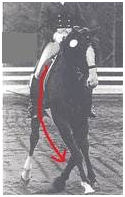 These two pictures juxtapose a competitive rider and a classy rider. I use the word classy instead of classic because some classical trainers have no class at all; they criticize competitive dressage but they promote the same errors. They teach the movements but do not focus on the coordination of the horse's physique allowing the horse to deal with the athletic demand of the performance. On the left picture, the competitive rider presents a dysfunctional horse executing half pass with an inverted rotation of the thoracic spine. By contrast, the rider with class, who, in the circumstance is Colonel Margot, presents a horse correctly coordinated for the athletic demand of the performance. Margot was another rider understanding intuitively the body coordination allowing the horse to perform soundly and at its utmost potential. Margot performed biomechanically correct half pass before the concept of proper or inverted rotation was identified and explained. CLICK HERE TO READ ON
|
|
Musings of a Science of Motion "Working Student"
Carol Shwetz IHTC member
I recently completed 4 weeks as a "working student" at the farm of Jean Luc and Helyn Cornille. I would like to share with other students my impressions and understandings.
First I would like to sincerely thank Jean Luc and Helyn for their extraordinary hospitality. The environment and format for learning and integrating my new understandings were well-suited. Jean Luc met me at the place of understanding and experience that I came with and from there we went forward. The ability of Jean Luc to translate scientific insights of functional equine biomechanics into the experience of riding such that it benefits both horse and rider is masterful. His intuitive style of teaching is very patient, kind, engaging and effective.
These are seven "learnings" or understandings that I would like to share. Really they are a "way of being" with horses which I hope to practise daily and perhaps one day accomplish mastery.
Resonant at the horse's frequency. Here I can listen to and hear the horse and discover wherever they are, This is a good place for harmony to begin. It looks like calmness. Calmness is a good beginning.
The horse gives "contact". The understanding of contact is crucial. After many afternoons under the Georgia spring sunshine a horse named Manchester and Jean Luc brought me closer to an understanding of "contact". With time the horse began following my hands and body to a place of lightness and grace.
Awareness of my own body is fundamental to any dialogue with the horse. Hands, shoulders, pelvis, or legs which dissociate send mixed messages and confuse the horse. Body awareness demands introspection and mindfulness for it is my body which becomes a corridor through which the horse's movement and energy is channelled.
Lightness and balance control come first and foremost. It can be no other way. At this moment the horse and I begin to engage in a place where communication bears no words. Having felt this place of lightness I desire to re-create it again and again. It all begins here. This lightness I speak of is light, light like a feather and from this place the horse's body moves with a gentle ease. It is the first position of the dance.
Shoulder fore is a specific body co-ordination that respectful prepares the horse's body for movements that follow. It is a place of lightness and brilliance. This moment is dynamic and of great benefit to both horse and rider. It is the first step of the dance.
The horse's ability to perceive is astounding...truly astounding. My hands are how I sense the horse's world and my hands are also how the horse senses my world. Forearm contraction closes the door quickly, very quickly..without exception. No worries though because when the horse becomes heavy on the forehand, I can feel that straightaway.
Understanding the functional biomechanics of the horse adds a depth and breadth to this level of horsemanship unknown before in history. As such this experience of horsemanship is delightful beyond words. Studying the scientific insights of functional biomechanics is like studying the eighth wonder of the world. Translating the studies into the riding experience is like knowing the eighth natural wonder of the world.
It is a wonderful wonderful way with horses!! So it is that my final sentence acknowledges Manchester, the horse, whom himself is a grand master, gifting me with what is possible by "feeling" what is possible.
Carol Shwetz DVM COAC IVAS ECS
March 14/14
|
|
Class-Sick
Jean Luc Cornille
Even when scientific knowledge was in its infancy, the father of classical equitation advised "an extensive progressive study of science." (Fran�ois Robichon de la Gueriniere, Ecole de cavalerie, 1731) Centuries before it was discovered and comprehensively explained, la Gueriniere intuited the concept of transversal rotation associated with lateral bending. "In the cervical and thoracic vertebral column, rotation is always coupled with lateroflexion and vice versa." (Jean Marie Denoix, DVM, PhD. Spinal Biomechanics and functional anatomy.1999) The lowering of the inside haunches, that la Gueriniere regards as the main value of the shoulder in demands precisely lateral bending of the thoracic spine associated with proper rotation. Correct rotation shifts the dorsal spines toward the inside of the bend. "In the thoracic spine, as is the case during lateroflexion, the spinous processes bend in the concavity." (Denoix). On this picture, Chazot executes the right shoulder in combining right lateral bending with the proper rotation, which is a rotation shifting the dorsal spines toward the inside of the bend. This correct rotation is illustrated with a red arrow.
The gravure illustrating Monsieur de la Gueriniere's shoulder In clearly shows that the classic author sensed and taught the concept of proper rotation.  La Gueriniere does not talk about proper or inverted rotation because the knowledge of such rotation was not available at his time. Even if la Gueriniere sensed the phenomenon, he could not explain it. I La Gueriniere does not talk about proper or inverted rotation because the knowledge of such rotation was not available at his time. Even if la Gueriniere sensed the phenomenon, he could not explain it. I 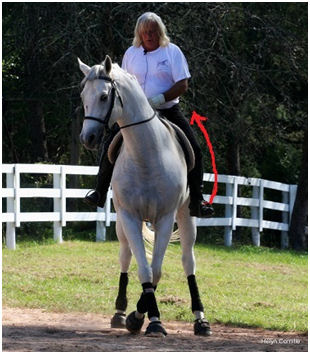 t took centuries before the existence of transversal or axial rotation associated with lateral bending was comprehensively explained. La Gueriniere was in fact closer from modern understanding of the equine vertebral column mechanism than many modern trainers who have developed excellent marketing strategies but poor understanding of the equine vertebral column mechanism. t took centuries before the existence of transversal or axial rotation associated with lateral bending was comprehensively explained. La Gueriniere was in fact closer from modern understanding of the equine vertebral column mechanism than many modern trainers who have developed excellent marketing strategies but poor understanding of the equine vertebral column mechanism.
Inverted rotation, which is illustrated on this picture with the red arrow, places the pelvis in the wrong inclination. The adduction of the inside hind leg is then stressing abnormally the cruciate ligaments of the stifle. Simplicity sells well but also cripples horses as well. Carl Sagan felt the need for a "baloney detection kit," a way for one to distinguish general falsehood from authentic information. Sagan refers to the baloney detection kit as "Bullshitt-Busting." Moving a horse side way touching his body with a whip does not require any skill and therefore, the technique is popular. 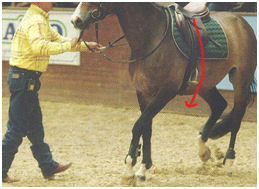 However, the comedy does not have any athletic, educative and never the less therapeutic advantage. In order to benefit from any gymnastic exercise, the horse's body has to be specifically coordinated. At the contrary, when a movement is asked without adequate orchestration of the horse's physique, the move induces abnormal stresses exposing the horse to physical pain and injuries.
|
|
Jean Luc and Chazot
Quote
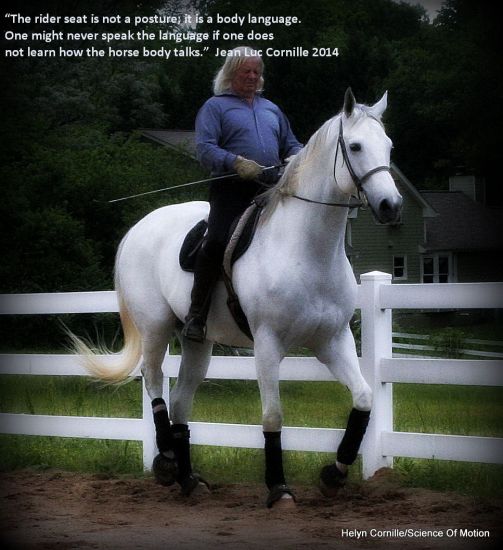 "The rider seat is not a posture; it is a body language. One might never speak the language if one does not learn how the horse body talks." Jean Luc Cornille 2014 |
|
Jean Luc and Chazot Forest ride
Video
 | | Chazot and JLC intro to forest |
Real calmness is when the horse athleticism matches the horse's spirit and energy. Build a real athlete and you will have a peaceful athlete. Cutting the food or making the horse falling in sleep in the ring out of boredom, is fake and dangerous. One event awakes the horse and the situation rapidly runs out of control. We have rented large acreage on the back of the property so we can run our conditioning program. At the walk, a slow a rhythmic trot or easy canter, the horses now have the pleasure to perform on a large area. The first one enjoying the new place was Chazot. It was not trot but rather bouncy canter but he truly loved it. In a few weeks we will record him practicing the pignot jog and you will see how even a highly spirited horse can work peacefully when his athletic development matches his energy. We will show you other techniques, both in hand and under the saddle that we use in our conditioning program for education and rehabilitation. Jean Luc
|
|
Sacroiliac in the horse, Brief segment from original
Excerpt
From Science of Motion with Jean Luc Cornille. A brief segment from a video for the IHTC students on SIJ problems and how to test. For more information on this course by Jean Luc go to scienceofmotion.com
 | | Sacroiliac in the horse, Brief segment from original |
|
|
Jean Luc and Chazot
Leaders
The greatest error of the training pyramid as well as the greatest error of most training techniques is fitting the horse to stereotypes. Morphology, style, spirit are components of the horse's talent, successes and soundness. They need to be supported by the physical and mental education. Touching the legs with a whip creates physical dysfunction. Leadership, when resumed to obedience is handicapping as well the horse's spirit. It is in fact, as explained by Carl Sagan, "propaganda, pseudoscience, and general falsehood." Without extensive knowledge of the performance's athletic demand, there is no leadership. The leader is not the one who holds the whip. The leader is the one who holds the knowledge. JLC
|
|
Cartoon
Jean Luc Cornille
|
|